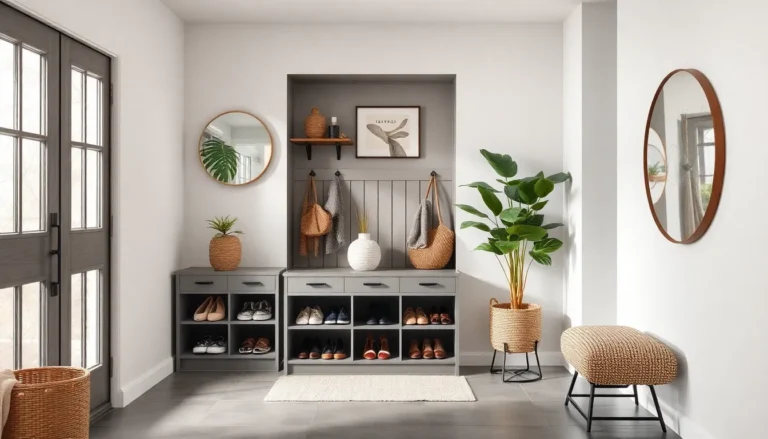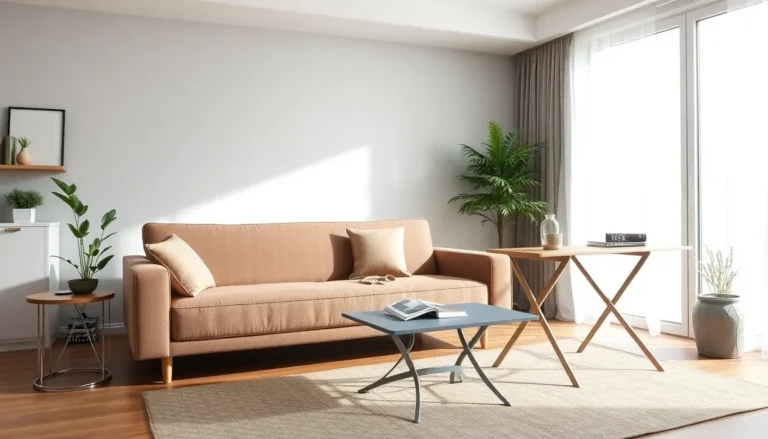In a world where store-bought decor can drain your wallet faster than a toddler can spill juice, DIY home projects offer a refreshing escape. Imagine transforming your living space with your own two hands, all while saving cash and dodging the dreaded “assembly required” instructions. Who needs a professional when you can channel your inner Picasso and unleash your creativity?
From upcycling old furniture to crafting unique wall art, DIY projects not only spruce up your home but also add a personal touch that no store can replicate. Plus, there’s nothing quite like the satisfaction of saying, “I made that,” while sipping your coffee and basking in the glory of your handiwork. So grab your tools and let’s dive into the wonderful world of DIY—where fun meets functionality and every project is a chance to show off your skills (or at least your ability to wield a paintbrush without creating a Jackson Pollock masterpiece).
Table of Contents
ToggleOverview of DIY Home Projects
DIY home projects encompass a wide range of activities aimed at improving living spaces. Creativity plays a central role, allowing individuals to personalize their environments according to taste. Cost-effectiveness remains a significant advantage; crafting decor often incurs lower expenses than purchasing retail items.
Furniture upcycling offers a popular option for DIY enthusiasts. Individuals transform old pieces into functional and stylish items, extending their lifespan while adding character to a room. Unique wall art projects provide another outlet for artistic expression. Many choose to create pieces that reflect personal experiences or preferred aesthetics.
Considerable satisfaction arises from completing DIY tasks. The sense of accomplishment available when a space changes entirely through personal effort enhances the appeal of these projects. Utilizing online resources, individuals can access tutorials and inspiration to kickstart their initiatives successfully.
Tools and materials are essential to achieving quality results. Gathering supplies in advance streamlines the process and minimizes frustration. Planning projects ahead of time leads to better execution and design coherence.
Each completed project serves as a testament to individual creativity and skill. Friends and families often appreciate the effort, which further fuels enthusiasm for future endeavors. DIY home projects thus represent not just tasks, but opportunities for growth and individual expression.
Benefits of DIY Home Projects

DIY home projects offer several advantages, enhancing both living spaces and personal satisfaction.
Cost Savings
Creating decor rather than buying it saves money. Many DIY projects involve repurposing materials, minimizing the need for new purchases. Using old furniture, pallets, or leftover paint cuts costs significantly. For instance, upcycling a worn-out table into a stylish new centerpiece can eliminate the expense of buying new furniture. Achieving a beautiful home doesn’t require a large budget; DIY methods provide cost-effective solutions without compromising quality. This financial benefit encourages experimentation, allowing individuals to pursue creative ideas without the risk of overspending.
Personal Satisfaction
Completing a DIY project delivers a profound sense of accomplishment. Many individuals find joy in seeing their efforts materialize into tangible results. Each finished project can reflect personal style and creativity, strengthening emotional attachments to living spaces. Creating custom wall art or transforming furniture instills pride, showcasing unique flair. Additionally, sharing these creations with friends and family often leads to positive feedback and encouragement, further fostering motivation for future projects. Engaging in DIY home improvements nurtures personal growth while providing fulfilling experiences.
Popular DIY Home Projects
Various DIY home projects offer creative ways to enhance living spaces. These activities range from home decor to gardening and furniture makeovers.
Home Decor
Home decor projects invite creativity and personal style into a space. Individuals often paint canvases or create custom wall art to express their personalities. Simple tasks like making decorative throw pillows or restoring picture frames can elevate a room’s ambiance. Homeowners enjoy repurposing items, transforming everyday objects into unique decor pieces. Using leftover materials cuts costs and minimizes waste, making it eco-friendly. These projects foster a deeper connection to the living environment, reflecting individual tastes and stories.
Gardening Projects
Gardening projects bring nature closer to home. Container gardens, vertical planters, and herb boxes enable urban dwellers to cultivate greenery in small spaces. Individuals can create raised garden beds to grow vegetables and flowers, improving outdoor aesthetics and producing fresh food. Crafts like building birdhouses attract wildlife, adding life and vibrancy to gardens. Seasonal planting and landscape design transform yards into personal sanctuaries. Gardening not only beautifies surroundings but also promotes relaxation and mental well-being.
Furniture Makeovers
Furniture makeovers allow for creative expression through redesigning old pieces. Painting, staining, or reupholstering furniture breathes new life into outdated items. Individuals engage in projects like adding new hardware or mixing and matching furniture colors to create cohesive looks. These endeavors also extend the lifespan of cherished pieces, making them functional and stylish again. Collaborating with friends or family on such projects fosters shared experiences and memories. Successful makeovers often lead to a heightened sense of pride and accomplishment in one’s home environment.
Essential Tools for DIY Home Projects
Equipping a workspace appropriately ensures smooth execution of DIY projects. Essential tools enhance efficiency and effectiveness.
- Screwdriver Set: A diverse screwdriver set contains both flat and Phillips head screws. Various sizes facilitate working with different hardware.
- Hammer: A reliable hammer aids in driving nails efficiently. Consider a claw hammer for both pounding and removing nails.
- Tape Measure: This tool ensures precise measurements for accurate cuts. A 25-foot tape measure suffices for most home projects.
- Level: Keeping surfaces even is crucial for aesthetics and functionality. A standard 24-inch level helps confirm items hang straight.
- Utility Knife: A sharp utility knife cuts through various materials. It comes in handy for opening boxes or trimming excess material from projects.
- Power Drill: A cordless power drill simplifies drilling holes and fastening screws. Look for models with adjustable speed settings for versatility.
- Pliers: A pair of pliers grips, twists, and cuts wires easily. Needle-nose pliers offer precision for intricate tasks.
- Safety Gear: Protective eyewear shields eyes from debris. Gloves provide hand protection against sharp objects and rough materials.
- Clamps: Using clamps secures pieces together while working. Having a few different sizes supports various project requirements.
- Workbench: A sturdy workbench provides ample space for assembling projects. Consider a portable workbench for flexibility in workspace arrangement.
These essential tools serve as a foundation for tackling any DIY home project. With the right equipment on hand, individuals can confidently transform their living spaces and enjoy the DIY experience.
Safety Tips for DIY Enthusiasts
Safety is paramount while engaging in DIY home projects. First, always wear appropriate personal protective equipment, including safety goggles, gloves, and masks, depending on the task. This gear minimizes exposure to harmful substances and injuries from tools.
Keep workspaces well-ventilated. Proper ventilation reduces inhalation of dust and fumes, ensuring a healthier environment for project completion. Utilizing a fan or opening windows can significantly improve air circulation.
Familiarize yourself with tools. Understand the purpose and proper handling of each tool before starting a project. Incorrect use can lead to accidents, so reading manuals and watching instructional videos proves beneficial.
Plan projects carefully. Develop a clear plan including materials, timelines, and methods to minimize errors. Listing steps in advance helps avoid costly mistakes and enhances safety.
Secure work areas. Ensure that tools and materials are organized and that the workspace remains free of clutter. This practice reduces trip hazards and increases overall efficiency while working.
Use ladders correctly. When tackling projects that require height, ensure ladders are stable and positioned on flat surfaces. Maintaining three points of contact at all times increases safety.
Take breaks. Working continuously can lead to fatigue, which increases the risk of accidents. Allow time for rest to maintain focus and ensure ongoing safety.
Store materials properly. Keep hazardous substances, like paints and chemicals, out of reach of children and pets. Ensuring proper labeling increases safety and awareness of potential risks.
Following these safety tips creates a secure environment for DIY enthusiasts. Prioritizing safety leads to enjoyable and successful project experiences.
Embracing DIY home projects opens up a world of creativity and personal expression. Each project completed not only enhances living spaces but also fosters a deeper connection to one’s home. The joy of transforming old items into something new can be incredibly fulfilling.
With the right tools and planning anyone can tackle these projects safely and effectively. The financial savings and sense of accomplishment that come from DIY endeavors encourage individuals to explore their creativity further.
Whether it’s upcycling furniture or creating unique decor pieces the possibilities are endless. By diving into the world of DIY home projects individuals can truly make their spaces reflect their personal style and experiences.



